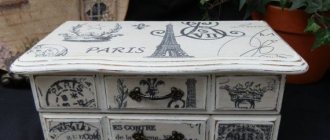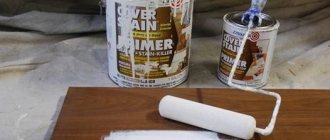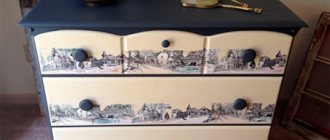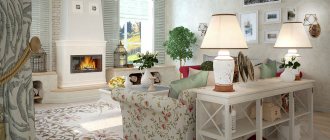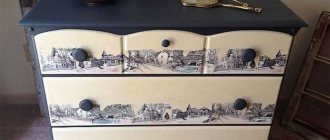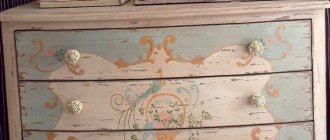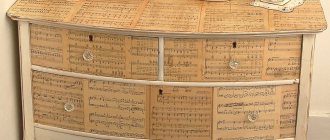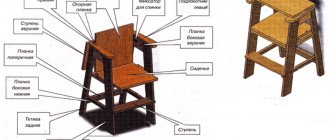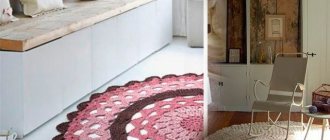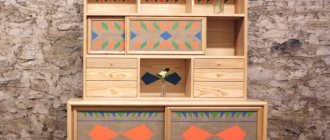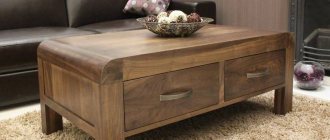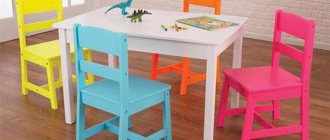/Furniture/Dining group/
There can be a great many reasons to renew old chairs or decorate new ones with your own hands. This includes the need to adapt furniture to the interior, the desire to correct design flaws, to restore chairs inherited from a grandmother or found for next to nothing at a flea market. In this material we will talk about 4 ways to transform “four-legged friends” (including office and garden chairs) beyond recognition, and also present 70 cool photo ideas for alterations.
See also: 3 easy ways to update your kitchen set
Features of the technology
Decoupage of old furniture is an inexpensive and very effective way to restore something that has served for a long time. For example, an old cabinet, dressing table, high chair, or even an entire countertop. With decoupage you can achieve several goals at once.
Having mastered the “decoupage” technique, you can significantly transform your interior.
Few people know, but the birthplace of this technology is Asia, namely China. It’s hard to guess, because the technique has a French name. The dawn of decoupage in Europe occurred in the seventeenth century AD, when wealthy Europeans decorated their estates with expensive household items from Asia. Venetian craftsmen, sensing a gold mine, learned to give an Asian look to their products.
Decoupage is an excellent option for transforming old but dear furniture.
In recent years, five main types of decoupage have become widespread in the creative world.
- Direct or classic decoupage is a basic and very common technique due to its simplicity. The principle is suitable for beginner craftswomen who are just starting to try their hand at decoupage and do not yet fully understand the principle of operation.
- Reverse decoupage is a decoration method in which an image with an ornament is glued to the reverse side of a glass product. Thus, the drawing will be protected from external influences by a layer of glass
The easiest way to decorate furniture with your own hands is decoupage.
- Smoky or artistic decoupage helps to imitate artistic painting with the help of paints; the boundary between the design and the ornament is almost completely erased and a translucent haze is formed.
- Many of those who went to kindergarten made various crafts there. For example, they tore finely colored paper and pasted it onto cardboard in the form of vases with flowers, colorful butterflies or little animals. So this turns out to be another type of decoupage! And it’s called paper deco patchwork.
This method of decoupage is definitely suitable for all ages and does not require any special skills, the main thing is to use your imagination.
- For more advanced craftsmen who have fully mastered the main principles and want to try something new, a volumetric type of decoupage is suitable. It consists in the fact that with the help of modeling paste, finely cut pieces of fabric, multi-layer napkins, putty and art gel, applications are created with the increasingly popular 3D effect. Working in such a technique really requires a lot of experience, perseverance and accuracy.
How to choose the right style for decoupage?
There are a large variety of decoupage motifs that are used to style furniture. Their choice is based only on the personal taste of the master and the goals that he has set for himself.
Napkins made of multi-layer paper, which are available to everyone, can become a suitable material for decoration.
Let's look at the most popular motifs used by craftsmen around the world.
- Floral motifs and pastel colors.
- Fruits, grape roses, whole bouquets of herbs.
- Religious theme.
- Birds, animals.
- Chinese and generally Asian motifs.
- Old black and white photographs and postcards.
Remember that you can always come up with your own motive, you just need to use your imagination!
We will also look at some stylistic trends in decoupage.
Provence and Victorian style have always been very popular. Both of these styles came to us from France. A whitened background, small abrasions, floral motifs and pastel colors are what characterize these styles.
Simple City. Created using neat (or, on the contrary, torn) newspaper clippings and old black and white photographs.
This stylistic trend is characterized by the deco patch technique.
Vintage French. The item is decorated using two, less often three, colors – white and black. This style was slightly influenced by minimalism.
If you see frayed edges and washed out textures, rest assured, it's Shabby Chic. The Victorian style with its hunting theme, gold, and bouquets of flowers very often echoes it.
It is advisable to purchase special decoupage glue.
Frost stool from Ikea - how to come up with decor?
The main advantages of the Frost stool are:
- Excellent compactness and the ability to stack one stool on top of another to save space.
- Very affordable price.
- Stylish look.
- No corners.
- Possibility of further varied decoration.
Let's try to fantasize about possible design solutions that the round seating surface and magnificent legs of a stool that can support a weight of 94 kilograms can encourage us to do.
What tools and materials will be needed?
Decoupage is a technique that opens up a large selection of different techniques and does not require large material costs. But if you still want to get high-quality and beautiful work as a result, then you will still have to spend a little money.
The decoupage technique for decorating furniture products is again at the peak of popularity.
List of materials and tools for furniture decoupage:
- Sharp scissors with short blade and Teflon coating. These will accurately cut out even the smallest parts, and glue will not stick to them. Also a short blade is easier to control
- Brushes. They may be needed for shading pastels, applying glue or paint. For pastels, choose soft, natural bristles, and for glue and paint, hard synthetics are suitable.
- Primer for preparing the work area
- Glue for decoupage.
- Acrylic paints for backgrounds and small details
- Sandpaper
- Napkins are the cheapest and most accessible material for decoupage. Nowadays there are a huge variety of napkins with different prints on the market. Even if you make a mistake, you won’t mind the money spent, because a pack of napkins costs a penny. But this option is not very durable and can tear easily.
- Decoupage napkins are a more expensive option, but have greater durability and covering ability. They are sold in specialized stores in already assembled sets on a specific topic.
- Prints are also an economical option, the main thing is to choose a clear picture and print on a laser printer.
- Also, advanced craftsmen can purchase a special knife for decoupage, which has a rotating blade.
Frost stool for children - swing, bicycle and sled
These simple IKEA Frost stool ideas are for the truly DIY dad. And children will be happy to watch the construction and use such toys!
DIY furniture decoupage with napkins
With the help of decoupage we can breathe new life into furniture that has served us for many years. Even unsightly Soviet furniture can sparkle with new bright colors!
In order for the work to be done cleanly and accurately, it is important to stock up not only with high-quality materials, but also with a lot of patience and creativity.
Although the technique is not the most difficult to perform, one wrong step can, it would seem, irrevocably ruin the entire product and discourage all desire to continue working. But show strength of character and correct the mistake. The most common problem is the appearance of small irregularities, bumps, folds on the work, spoiling the entire appearance. If the folds are really small, then fixing varnish can help correct the situation. There is no need to spare it; apply a large number of layers. If the folds are large, then it makes sense to sand them a little with soft sandpaper to remove the thickness.
It is important to let each layer dry thoroughly so that it does not turn out to be a mess.
Correct preparation of the surface for decoupage will also help to avoid mistakes.
To ensure that the ornament you have chosen does not tear during the process, does not swell and lies flat, the wood must be carefully processed before work, getting rid of all knots and twigs, and unevenness on the surface. Walk over the entire working area first with coarse sandpaper, and then switch to soft sandpaper, achieving a perfectly smooth surface.
If you are working on glass or plastic, then to avoid the ornament slipping, you should thoroughly degrease the work surface before applying it. This can easily be done with alcohol and alcohol-containing products or dishwashing detergent.
Preparation for decoupage of a metal surface is similar to glass or plastic.
More thorough preparation is carried out in cases where corrosion has formed on the metal, also known as rust. It will definitely need to be removed, otherwise disgusting dirty yellow spots will appear on the ornament.
A poor primer is the main cause of mold and mildew on finished work. Also, if this step in the work is skipped or done carelessly, then the work can creep, because the primer is the connecting element between the base, glue, napkin and varnish. It is more profitable to prime glass and plastic with artistic acrylic primer; wood is primed with wood primer, which can be purchased at any hardware store.
Decoupage is a fascinating and uncomplicated activity that has many techniques and is accessible to even the youngest craftswomen.
Note! If you follow all the rules for preparation and strictly follow the plan, use high-quality materials, then the work will bring you only joy.
Master class on decoupage of a chest of drawers with napkins
The chest of drawers will be decorated in Shabby Chic style.
You want to update your old, boring chest of drawers - what could be easier!
Step 1. Prepare the furniture for creative work. We disassemble it, remove all the fittings and sand it thoroughly, removing the top layer. We prime and then paint.
Step 2. Cut out blanks for decoupage from napkins, wallpaper or magazines, you can use printouts. Once placed on the furniture, find the ideal location for the flowers.
Step 3. Mix glue with water in a ratio of 2/3. We glue the motif to the chest of drawers, coating everything well.
Types of stools
It is difficult to imagine a house, cottage, apartment where this item would be absent. People have known this product since childhood. The name itself was borrowed from the German language from “taburétt”, according to the etymological dictionaries of M. Vasmer, published between 1964 and 1987. Other sources claim that the word came into Russian from the French “tabouret”.
To produce products on an industrial scale, manufacturers use different raw materials: wood and its derivatives (plywood, chipboard, MDF), plastic, metal. Depending on the model, the surface of the seat is covered with a soft cushion, some are left without upholstery. According to the shape, there are round, square, triangular options. You can also divide all products by height: low, high. If we take into account the appearance of the structure, its purpose and structure, we can distinguish the following types:
- children's;
- box stool;
- folding (tourist);
- soft;
- step stool;
- country house
Children's
A baby stool is one of the first pieces of furniture that a child uses in everyday life. The kids sit on it, use it as a stand, and if necessary, reach for the thing that interests them, located high up. It is very important that the item is comfortable, durable, and safe. Purchased models do not always meet these requirements.
The main difference between this option and the standard design is its size and height. Small furniture is lighter in weight, takes up little space, and is easy to carry. Even a small child can cope with this task. This item is very comfortable for adults to use, especially for older people who use it as a footstool.
When making your own, you should consider some points:
- the material should not be toxic; only natural wood should be used for work;
- the board should not have flaws, knots, cracks;
- after assembling the product, all sharp corners must be rounded;
- clean the surface from burrs and polish;
- cover the surface with special harmless acrylic paint and varnish.
Box stool
For people with small living spaces who are trying to save every centimeter of free space, this item will be very useful. A compact stool with a special compartment for various things is the standard of practicality. The product will be in demand by both women and men.
If you place it in the kitchen, the box can be used to store towels, napkins, oven mitts, and other kitchen utensils. If a man uses it, the product will become very weighty due to the hammer, wire cutters, pliers, and other improvised tools and consumables located inside.
To make such a structure, you should choose a durable board and beam, which will be used as a drawer and legs, respectively. The seat is cut out of MDF or chipboard; a regular sheet of plywood is suitable for the bottom. Some craftsmen make drawers mounted on guides.
If a more spacious model is required, then the stool can be made without legs, allocating the entire space from the seat to the floor for a drawer.
With soft seat
Many people are not satisfied with a hard seat, so when making the product themselves, they make a soft base. It can be removable or sewn on. The first model is convenient because it can be removed and washed at any time. The second option is rigidly fixed to the surface, so cleaning the fabric material is problematic. Various raw materials are used as filler; the most common types include:
- Synthetic materials:
- Foam rubber. One of the most budgetary types, however, it wears out quickly.
- Sintepon. Characterized by a very short service life.
- Asselex. More expensive component. It is elastic, retains its shape well, and is more expensive than previous analogues.
- Spunbond. It has all the positive properties of the parent substance, and it is also hypoallergenic.
- Natural:
- Horsehair. Pretty tough.
- Coconut coir. Soft material.
The following is used as upholstery:
- Genuine Leather;
- synthetic leather;
- textile.
Separately, we can highlight products with wicker seats. To make it, you only need a frame. The base is formed from different materials. Rope, leather, artificial trouser belts, rubber, and other available raw materials are suitable for work. You can weave a seat in different ways; both diagonal and straight weaving will look interesting.
Folding
The stool is characterized by compactness, mobility, versatility, and practicality. This item is used for different purposes. It can be installed in the kitchen of a small apartment, taken with you fishing or outdoors, it can easily be used in the country house or in the garage. However, this design is less durable compared to the standard model, and the folding parts often fail.
The product consists of a seat, a drawer, lower crossbars, legs, and a folding mechanism. Depending on its purpose, it is made of metal or wood. May have a round or square seat. In the absence of a ready-made drawing, choosing dimensions is very difficult. You can make the simplest options yourself.
To make complex structures at home, you will need special equipment for processing wood, because making perfectly smooth rounded edges by hand is very problematic.
Step stool
This model occupies a separate place, as it combines several items: a ladder, seating furniture. There are options with a drawer, which makes such products multifunctional. The main feature of the stool are the steps attached to its legs. Such an item will always come in handy, both at home and at work. There are several types of combined designs:
- Stationary. They are ladder-stools without retractable mechanisms. They have a peculiar shape in the form of a small unfolded stepladder.
- Folding. They can be represented by a regular folding stool, the legs of which have steps on one side. There are more complex designs that look no different from standard products - the steps are located under the seat. Among them are folding and retractable options.
You should choose thick boards for steps and seats, and strengthen the supporting legs. When making these stools, first of all, you need to take care of their strength, since they will be used for work at a certain height. For example, in the house, if necessary, to replace a light bulb, in the library, for the convenience of working with books located on the upper floors, in the garden, for comfortable fruit picking.
Stool for the garden
At the dacha, you can use old furniture stored in the attic, which is a shame to throw away, but is suitable for restoration. If you plan to manufacture new models, then you should think about the fact that in most cases the stool will be located on the street. Therefore, you can use any available material for work. Suitable pieces of iron, previously used wood, which, even if it rots and becomes unusable under the influence of precipitation and sunlight, this will not lead to regret.
To build summer cottages, there is no need to use first-class wood or metal. For these purposes, old pallets, building materials remaining after construction, wood cuts for making a seat, strong branches, and fittings for support legs and poles are suitable. Using available raw materials, you can create an inexpensive product. To extend the service life, the finished product is treated with special compounds, painted, and varnished.
The structure can be installed on the veranda, in the summer kitchen, or used in the gazebo if guests arrive and there is not enough space for them on the bench. The stool will also be an excellent help when harvesting in the garden. The product should not be left outside for the winter; it should be brought indoors. If you do periodic visual inspection on time and touch up the paint, then the homemade item will last for quite a long time.
